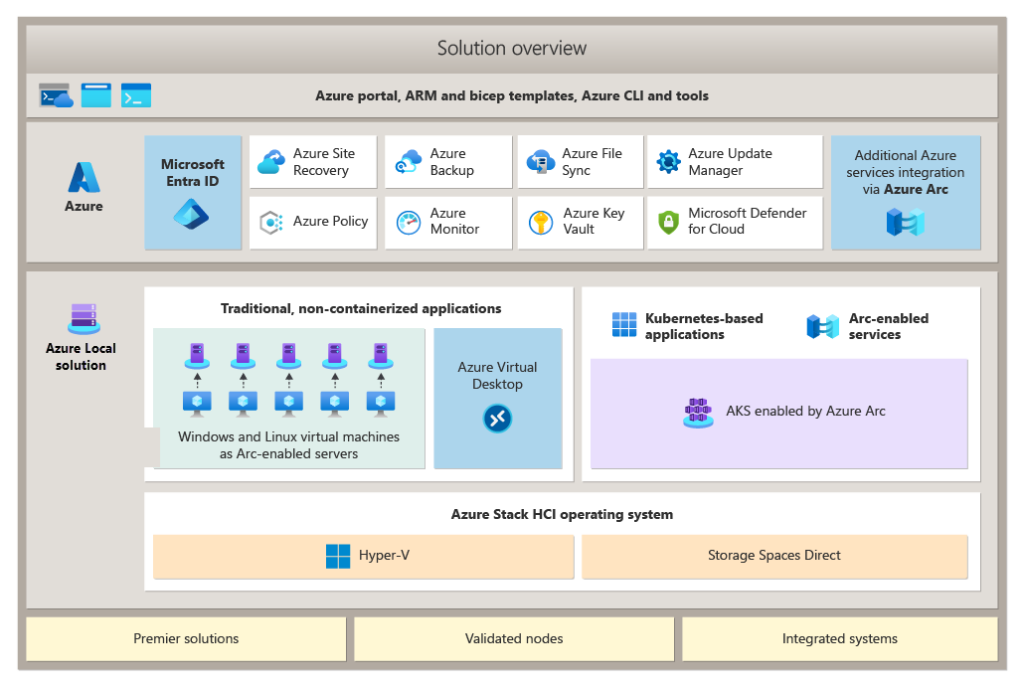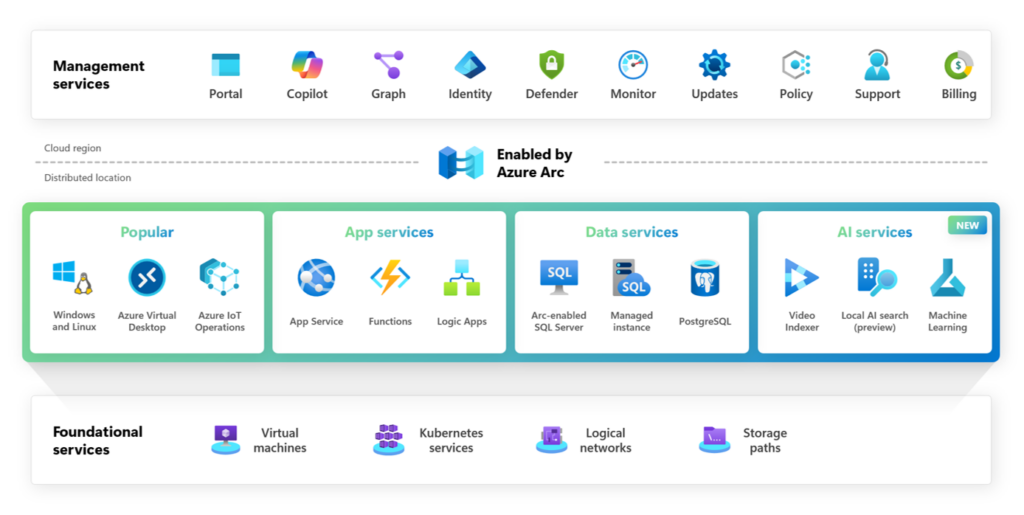Introducing Azure Local, the new home for Azure Stack HCI and cloud-native applications at the Edge.
Microsoft recently announced at Ignite the introduction of Azure Local link which initially is a pivot of the Azure Stack HCI solution neatly combined with Azure Arc under the new Local brand. There is also a slew of new features coming to Azure Local / Arc that overcome many of the issues that prevented the previous solution from applying to a wider variety of use cases, most notably at the edge.
The new features in preview, with an intent to go into general availability in 2025:
- Remote Provisioning:
A nifty feature that allows hardware to be shipped to the site and configured remotely via the Azure console using a unique token which maps to the server.
- Removal of the need for on-premises Active Directory:
Previously this was an issue for edge deployments as an external DC was required to build the cluster. Azure Local can now run with a local identity with Azure Key Vault, removing the need for Active Directory.
- Disconnected Operations:
This provides the ability to host the backend Azure portal, Azure Resource Manager, and Azure services like Key Vault yourself in your environment, packaged as a sizeable VM appliance. Similar to what Azure Stack Hub was trying to achieve, but which never had the right price point.
- Network Segmentation:
Network Security Groups are coming to Azure Local offering the ability to lock down network access to resources, and filter network traffic between VMs using inbound and outbound allow and deny rules.
- Azure Migrate VMware > Azure Local:
This is a long time coming and is still in preview. There is a lack of market migration tools outside of backup technologies so this opens up much-needed capability that has been holding Azure Stack HCI back.
- Trusted Launch:
Trusted launch is a security option that hardens VMs against malware-based rootkits and boot kits.
- Small form factor deployments:
Azure Local supports a new class of devices with reduced hardware requirements. This new, low-cost hardware class is suited for various edge scenarios across the industry verticals.
- AKS is now included for no additional cost:
This is a significant change as starting with Azure Local 2402 release Azure Kubernetes Service enabled by Azure Arc is included under the (currently) £8 for physical core/month Azure Local service fee.
The above features and strategy direction of Azure Local have added huge capabilities that open up more edge computing use cases and this is a huge leap in functionality compared with competitive services such as AWS outposts.
A strategy focused on cloud-connected, distributed infrastructure
“Enabled by Azure Arc, Azure Local is cloud-connected infrastructure that can be deployed at your physical locations and under your operational control. With Azure Local, you can operate and scale distributed infrastructure using Azure portal and APIs.”
Group Product Manager for Azure Distributed Infrastructure
Azure Local is very much positioned to augment Azure and although a lot of the new features open up smaller form factors, the original Azure Stack HCI position for datacentres is still very relevant and helps IT teams address two personas of distributed computing namely datacentre and edge workloads.

Hypervisor “with benefits” – Azure Local enabled by Arc for data centre workloads
Azure Stack HCI is very much a key component of Azure Local. Node4 were an early adopter of Azure Stack HCI and Azure Arc, launching our Azure Hybrid Service (Market First for Node4 as it launches a revolutionary Managed Azure Hybrid Cloud Solution). We have seen some fantastic applications and growth in service capability.
Azure Local combined with Azure Arc provides a mature platform capable of being able to natively support virtual machines, Kubernetes and a sprinkling of Azure capabilities such as Azure Site Recovery, Update Manager and Defender for Cloud.
Azure Local brings the following capabilities that our customers find useful for predominantly data centre workloads:
- Azure Virtual Desktop – The only platform capable of running AVD host pools outside of Azure which is useful where you need to reduce latency.
- Free ESU’s – As Azure Local is classed as an Azure service you gain the benefit of free End of Life security updates for Windows & SQL Server.
- Ability to use Azure Hybrid Use Benefit: Leverage your SA agreements to license Microsoft technologies.
- High-performance Databases: The Azure Stack HCI OS and hardware integration have been designed to deliver high performance to SQL Server workloads.
- Track Security compliance: Using Policy blueprints, Arc and Defender for Cloud there are a number of out-of-the-box compliance reports for standards such as ISO 27001.
Cloud-native applications at the edge
The big shake-up in applicable use cases is at the Edge especially the ability to run cloud-native applications. Azure Local enabled by Arc provides a range of Azure “PaaS” services such as functions, App Service, IoT operations and Azure SQL MI that have been containerised and can run at the edge.

- GitOps: Native integration with GitOps to easily deploy and update applications straight to edge devices.
- Easily deployed resilience: Using 2 small factor servers and storage spaces directly, it’s very easy to create a hyper-converged cluster, providing data resilience and high levels of business continuity at the edge. The ability to also use Azure Site Recovery means any VMs can be “one-click” replicated into Azure for DR.
- Cloud Native Services: Bring your cloud-native apps to the edge with Functions, Machine Learning, Local AI search, Kubernetes and Logic Apps.
- Easy to ship and provision: The new features allow IT admins to ship devices to remote locations and configure them remotely.
- Small form factor and ruggedised devices: The introduction of the smaller form factor opens up the use cases and lowers the cost, working with partners such as Lenovo there is a range of ruggedised devices that can meet the most demanding of environmental conditions.
As AI and data processing make more sense to do at the edge, Azure Local offers a game-changing option to run cloud-native applications outside of the cloud offering huge benefits to a wide range of industries including retail, manufacturing, transport and logistics.
Seamless transition for existing customers
For existing Azure Stack HCI customers, the transition to Azure Local will be seamless. There is no action required on their part, as the upgrade will be automatic. This ensures that businesses can continue their operations without interruption while benefiting from the enhanced features and capabilities of Azure Local.
How can Node4 help?
Node4 has been operating Azure Arc and Azure Stack HCI services since the launch of our Azure Hybrid Cloud platform Market First for Node4 as it launches a revolutionary Managed Azure Hybrid Cloud Solution.
Here are a few of the ways that we can help organisations leverage the power of Azure Local.
- Our design workshops are available to review use cases appropriate for Azure Local and create costed designs.
- We have several Proof-of-Concept clusters available to clients for testing.
- Our Azure Hybrid Cloud platform is available today for Data Centre consolidation projects to augment and complement Azure.
- Our hardware partners offer a range of edge devices including small form factor ruggedised models, suitable for harsh environments.
- Node4’s digital team are able to design cloud-native applications for edge devices bringing together our data, AI, development and DevOps capabilities.
- We also have a field services team available to support edge deployments.
